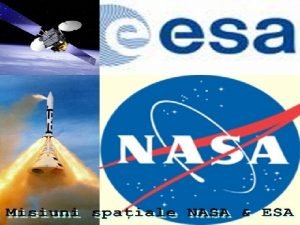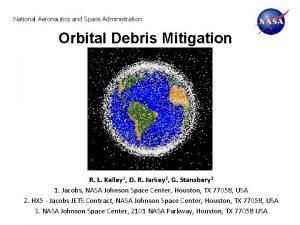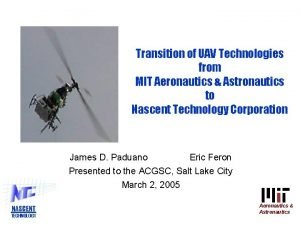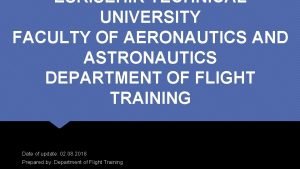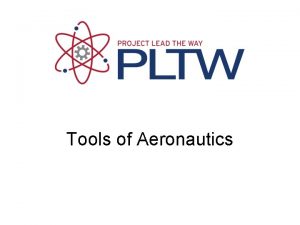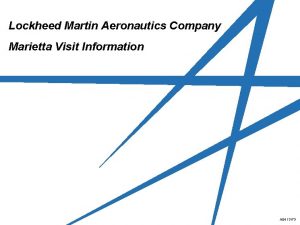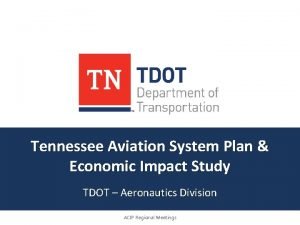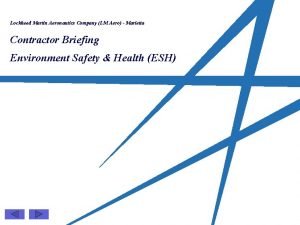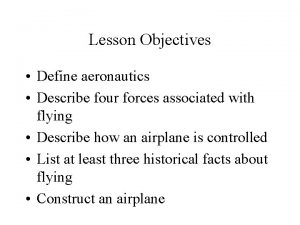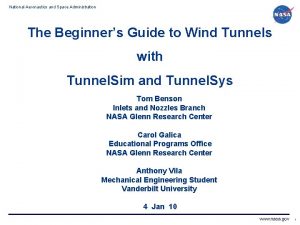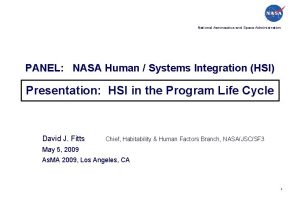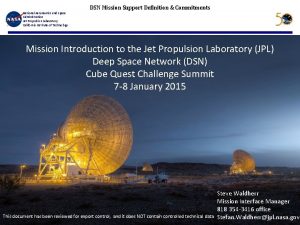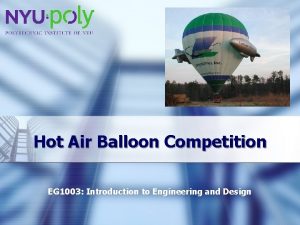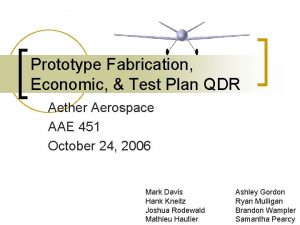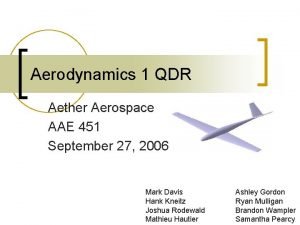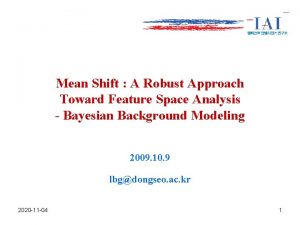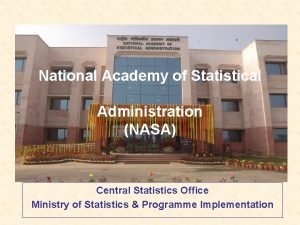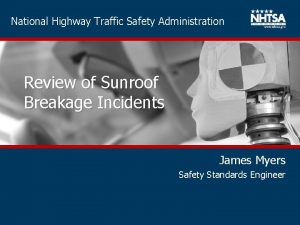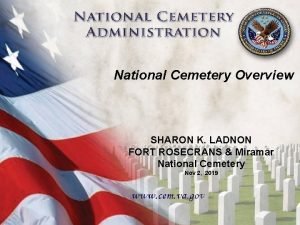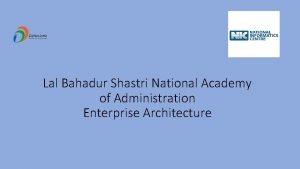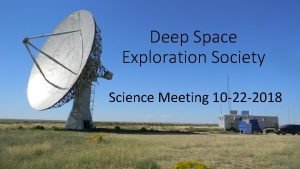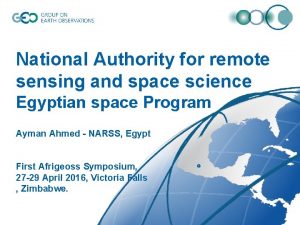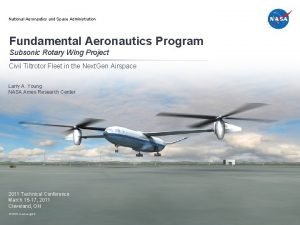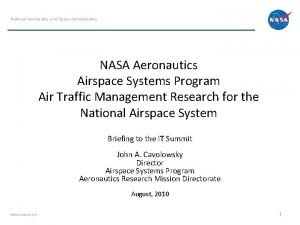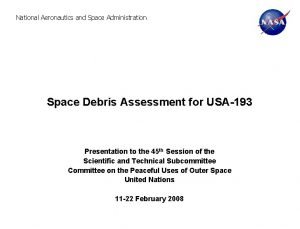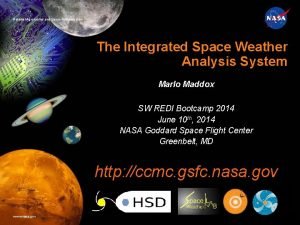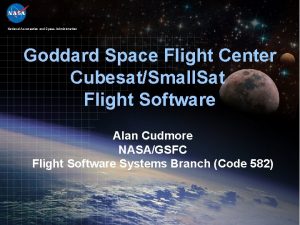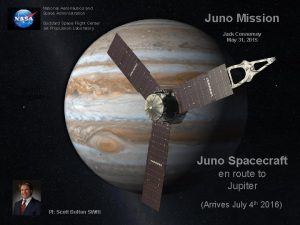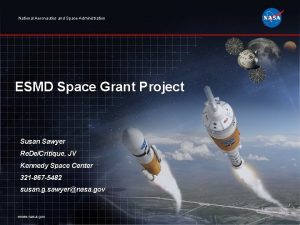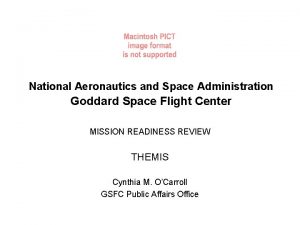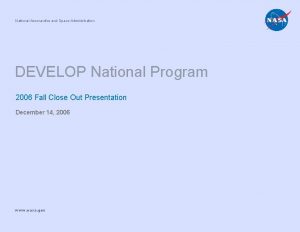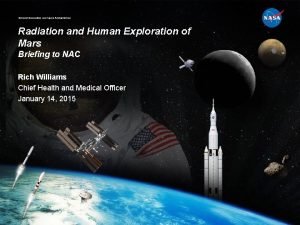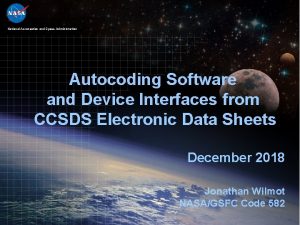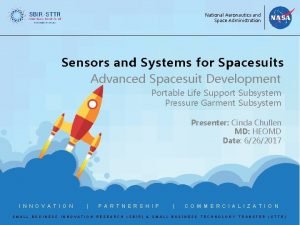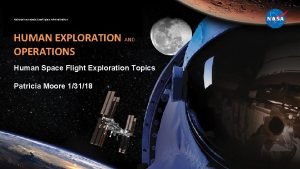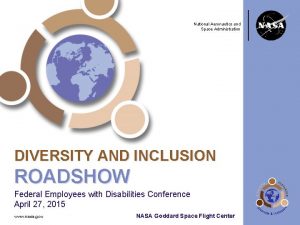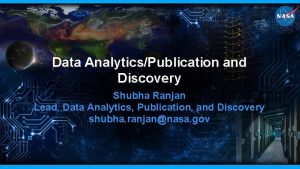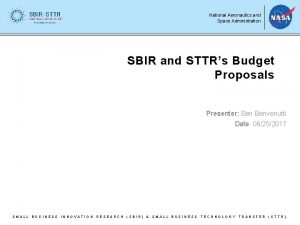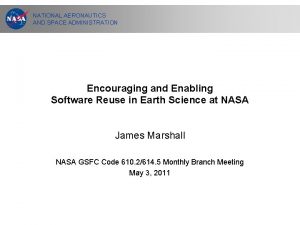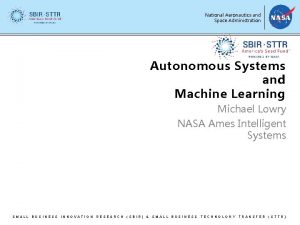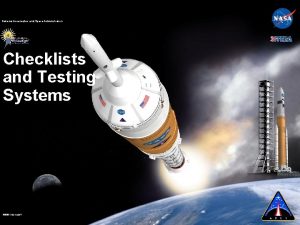National Aeronautics and Space Administration Toward Deep Space































- Slides: 31

National Aeronautics and Space Administration Toward Deep Space Exploration: Small Steps versus One Giant Leap Andrew Thomas FISO Telecon 12 October, 2011

The Emerging Environment and The Gap ISS Operations 2012 2013 2014 Comm. Crew Dev. End of Shuttle 2015 2016 2017 2018 2019 2020 2021 2022+ Commercial Crew Operations to ISS – Space Tourism Crewed Missions MPCV/SLS Uncrewed Missions MPCV/SLS Test The next decade in human space flight. Missions will be challenging for the Agency Robotic Andrew Thomas, Astronaut Office Science Mission Directorate, International, Commercial 2

The Emerging Environment and The Gap When Commercial Crew succeeds, the public will start to ask – Why do we need NASA? – The Agency needs some tangible advances (Fire and Smoke!) ISS Operations 2012 2013 2014 2015 2016 2018 2019 2020 2022+ Chinese on the Moon? Crewed Missions Uncrewed Missions 2021 Commercial Crew Operations to ISS – Space Tourism Comm. Crew Dev. End of Shuttle 2017 MPCV/SLS Google Lunar XPrize MPCV/SLS Test The next decade in human space flight. Missions will be challenging for the Agency Robotic Andrew Thomas, Astronaut Office Science Mission Directorate, International, Commercial 3

Some National Human Space Flight Projects u Apollo – Cancelled as soon as goal was achieved – we should not forget that public interest wanes very quickly u Shuttle – Approved for defense reasons, but started becoming unsustainable after DOD pulled out, and cancelled after Columbia u SEI – Congressional ‘sticker shock’ and cancelled u ISS – Suffered the legacy of ‘Freedom’, passed by only 1 vote, saved by Russian partnership u VSE and Constellation – Politically and economically unsustainable More programs are cancelled than finished - This does not bode well for the future human missions to deep space Andrew Thomas, Astronaut Office 4

Why Have Big National Programs Become Unsustainable? u Irrelevance - When they are seen as no longer relevant (e. g. Apollo after July 1969) u Affordability Sticker Shock - When they are seen as not cost effective – e. g. Ares I was cancelled but Space X support continues (Not to be confused with cost over runs James Webb will probably fly) u Lack of Progress - When there is little perceived progress forward in a way that has value in the eyes of the public (e. g. Freedom) u Unacceptable Risk – The risk-averse culture of today would never allow Apollo Andrew Thomas, Astronaut Office 5

“Boldly Going” Is Not Enough: Need to be Relevant History Tells Us What That Means u Economic Security/Commerce: • • • Columbus and 1492 Interstate Highway System Tennessee Valley Authority, TVA Wealth u National Security/Defense: • • Great Wall of China Manhattan Project Interstate Highway System Apollo, Shuttle, Freedom War u Spiritual Security/Deity: • • The Pyramids Gothic Cathedrals The Crusades Apollo Wonder Today, successful programs must be seen to have relevance in one or more of these areas, and it must be near term Andrew Thomas, Astronaut Office 6

Affordability - NASA Annual Budget Then-Year Dollars, 1990 - 2011 20 000 18 000 16 000 14 000 10 000 8 000 6 000 4 000 2 000 Andrew Thomas, Astronaut Office 2011 2010 2009 2008 2007 2006 2005 2004 2003 2002 2001 2000 1999 1998 1997 1996 1995 1994 1993 1992 1991 0 1990 $M 12 000 7

Affordability - NASA Annual Budget as Percentage of Federal Budget, 1990 - 2011 1, 2 This does suggest little real support for NASA from both parties 1, 0 0, 6 0, 4 0, 2 Andrew Thomas, Astronaut Office 2011 2010 2009 2008 2007 2006 2005 2004 2003 2002 2001 2000 1999 1998 1997 1996 1995 1994 1993 1992 1991 0, 0 1990 % 0, 8 8

Affordability - NASA Annual Budget as Percentage of Federal Budget, 1990 - 2011 1, 2 This does suggest little real support for NASA from both parties 1, 0 0, 6 0, 4 NASA Budget will be zero in 2030! (or Federal Budget will be infinite!) 0, 2 Andrew Thomas, Astronaut Office 2011 2010 2009 2008 2007 2006 2005 2004 2003 2002 2001 2000 1999 1998 1997 1996 1995 1994 1993 1992 1991 0, 0 1990 % 0, 8 9

Affordability - NASA Annual Budget in 1991 Dollars 1991 - 2011 16000 14000 12000 10000 8000 6000 This will likely trend further downward in coming years Big $ programs will come under scrutiny 4000 2000 Andrew Thomas, Astronaut Office 2011 2010 2009 2008 2007 2006 2005 2004 2003 2002 2001 2000 1999 1998 1997 1996 1995 1994 1993 1992 1991 0 1990 $M 10

Progress – What Does That Actually Mean? u The visible progress of the lunar program contributed to its success (Mercury, Gemini, Apollo 8) u The perceived lack of progress of ‘Freedom’ contributed to its demise u The shuttle program was seen as not advancing and that was another contributing factor to its cancellation (CAIB asked why were we doing this? ) u Progress must be demonstrable and visible, that is it must have ‘street appeal’ rather than arcane science and engineering • Kepler has found > 1000 exo-planets, but does the public care? Progress must exist in the eyes of Congress and the Public, and they do not measure it in technical terms Andrew Thomas, Astronaut Office 11

Risk – What Is Acceptable? u Kennedy would not let John Glenn fly again, as the risk was too great u Many NASA mangers breathed a sigh of relief when Apollo was cancelled u After Columbia, the CAIB asked why would such risks be incurred ‘just for a science mission’. They wanted a stronger justification u Leading congressmen today, state openly that another accident is unacceptable Risk must be driven as low as possible with good engineering but ultimately the US public will only accept the risk if they see a return that justifies it (Relevance) Andrew Thomas, Astronaut Office 12

The Challenge – National Relevance, Affordability, Progress and Acceptable Risk u Relevance - Without support from one or more of the Big 3 ‘Wealth, War or Wonder’, large scale, expensive national programs are not viable u Affordability - There seems to be a ‘cost threshold’ of about $1 B above which activities become too visible and therefore vulnerable u Progress - Whatever we do must have demonstrable progress. For the public this requires ‘street appeal’, and not just arcane engineering advances u Risk – We must develop activities that carry ‘acceptable’ risk The Agency has many missions in study, but how many of them match to one or more of these challenges? Andrew Thomas, Astronaut Office 13

In the Face of Modern Realities No More Giant Leaps, So Take Small Steps u Can we assemble a series of small projects (not big programs) that are shortterm, acceptable in risk and cost, and individually show tangible progress (street appeal), but…. . u ……but which in aggregation are such that they build toward a collective deep space capability and support national interests u This requires frugal and innovative ways to produce ‘Beyond-LEO’ transportation elements while keeping costs below the $1 B visibility threshold • • • Exploit partnerships (international, commercial) - but that is not enough Utilize existing assets to the greatest practical extent (reuse, re-purpose, etc. ) Integrate with other current or planned flight projects to the greatest extent Use ISS as an Exploration Development and Flight Test Center Use Robotic missions, tactically, to flight qualify systems and sustain public interest Use an integrated cadence of small missions to steadily build and qualify flight elements and a national deep space capability Andrew Thomas, Astronaut Office 14

Enablers for Deep Space Travel Solar Electric Propulsion • • Specific impulse = 2000 s Total power = 300 k. We Chemical Propulsion Stage • • • LOX/LH 2 Zero-boiloff cryo management Specific impulse = 455 s Space Exploration Vehicle • • • Deep Space Habitat • Sized for a crew of 4 for 400 days • • Total Volume ~168 m^3 Nominal mass ~ 28 t Advanced EVA Primary purpose is for exploration of NEA’s • Supports crew of 2 for 28 days Exploration suit development • Suit-port based Nominal mass = 6. 6 t Robotics EVA Module • • Provides EVA support Provides robotic manipulators Multi Purpose Crew Vehicle • Same assumptions as HEFT (CTVE-AE configuration) • • CM inert = 9. 7 t SM inert = 4. 7 t Andrew Thomas, Astronaut Office Space Launch System • • Evolved SLS capability No specific design assumed Gross Performance ~ 130 t Net Performance ~ 120 t 15

Possible Innovative Approaches – Crewed Elements u Deep Space Habitat (DSH) – It is all about the ECLSS: • Send ECLSS systems up to ISS on an ATV and outfit current MPLM • Outfit Node STA or MPLM and launch to ISS on ELV • Outfit commercially provided element with ECLSS etc. and launch u Space Exploration Vehicle (SEV): • Utilize an existing module as an MMSEV systems test bed (Exploration Test Module, ETM) • Deploy MMSEV cab to ISS and operate on SSRMS • Add RCS sled to MMSEV to create free flyer u Robotics EVA Module (REM): • Utilize shuttle airlock, RMS or ‘Strella’ • Utilize ETM, scavenge shuttle airlock systems u Advanced EVA: • Utilize ISS as testbed and lever ISS resources Andrew Thomas, Astronaut Office 16

Possible Innovative Approaches – Propulsive Elements u Solar Electric Propulsion (SEP): • Deploy candidate thruster on ISS for reboost (in planning) • Deploy candidate array on ISS to augment ISS power • But at some point a significant investment is needed u Cryo-Propulsion Stage (CPS): • What upper stages are currently available that might provide interim support to deep space missions? - Russian – Briz-M, Block-D, Soyuz 3 rd stage - US – Centaur, Falcon 9 2 nd stage - Europe – EPS, ECA (Ariane 5 2 nd stages) - Japan – H-IIB second stage • Utilize components for an ‘interim’ CPS Andrew Thomas, Astronaut Office 17

Build a Deep Space Capability on the Existing Agency Activities ISS Flight Test and Demonstration 2012 2013 2014 2015 Comm. Crew Dev. 2016 2017 2018 2019 2020 2021 2022 + Commercial Crew Operations to ISS To Deep Space and Beyond Crewed Missions MPCV/SLS Uncrewed Missions Google Lunar X-Prize MPCV/SLS Test Robotic Missions Andrew. Directorate, Thomas, Astronaut Office Commercial Science Mission International, 18

Build a Deep Space Capability on the Existing Agency Activities Exploration Mission Development and Validation HAT, OCT, AES, Field Exercises (Desert Rats, NEEMO) etc. ISS Flight Test and Demonstration 2012 2013 2014 2015 Comm. Crew Dev. 2016 2017 2018 2019 2020 2021 2022 + Commercial Crew Operations to ISS To Deep Space and Beyond Crewed Missions MPCV/SLS Uncrewed Missions Google Lunar X-Prize MPCV/SLS Test Robotic Missions Andrew. Directorate, Thomas, Astronaut Office Commercial Science Mission International, 19

Make Tactical Use of Key Robotic Missions Start by filling the gap with robotic missions that build the capabilities needed for in-space Exploration Mission Development and Validation HAT, OCT, AES, Field Exercises (Desert Rats, NEEMO)elements etc. assembly and deployment of deep space • Saves a satellite (orbital debris mitigation) ISS Flight Test and Demonstration • First film of a 2016 lunar landing 2012 2013 2014 2015 2017 2018 2019 2020 • Quietly re-affirms US presence at the moon Comm. Crew Dev. Commercial Crew Operations to ISS • O 2 & H 2 O generation on the moon • Tracking a NEA Robo. R 2 IVA/EVA 2021 2022 + To Deep Space and Beyond Robotic Insp. Crewed Missions Uncrewed Missions MPCV/SLS GEO Sat Service Google Lunar X-Prize Micro Lander 2 nd Lander/ ISRU NEA Beacon MPCV/SLS Test Robotic Missions Andrew. Directorate, Thomas, Astronaut Office Commercial Science Mission International, 20

Demonstrate In-Space Servicing and Advanced EVA Concurrently, develop advanced EVA and an Exploration Testand Module (ETM) at ISS and follow Exploration Mission Development Validation HAT, OCT, AES, Field Exercisesservicing (Desert Rats, NEEMO) etc. with satellite or Hubble mission 2012 • Saves Hubble – Agency credibility ISS Flight Test and Demonstration • Credible use of humans in space 2013 2014 2015 2016 2017 2018 2019 2020 Comm. Crew Dev. 2021 2022 + Commercial Crew Operations to ISS EVA Expl. Suit Adv. EVA To Deep Space and Beyond ETM Robo. R 2 IVA/EVA Robotic Insp. Crewed Missions Uncrewed Missions Satellite Service Hubble, Nat. Sec. GEO Sat Service Google Lunar X-Prize Micro Lander 2 nd Lander MPCV/SLS Lander/ ISRU NEA Beacon MPCV/SLS Test Robotic Missions Andrew. Directorate, Thomas, Astronaut Office Commercial Science Mission International, 21

Andrew Thomas, Astronaut Office 22

Establishes Uncrewed Assembly, Mission Ops. , and Advanced EVA Exploration Mission Development and Validation HAT, OCT, AES, Field Exercises (Desert Rats, NEEMO) etc. ISS Flight Test and Demonstration 2012 2013 2014 2015 2016 2017 Comm. Crew Dev. 2018 2019 2020 2021 2022 + Commercial Crew Operations to ISS EVA Expl. Suit Adv. EVA To Deep Space and Beyond ETM Robo. R 2 IVA/EVA Robotic Insp. Crewed Missions Uncrewed Missions Satellite Service Hubble, Nat. Sec. GEO Sat Service Google Lunar X-Prize Micro Lander 2 nd Lander MPCV/SLS Lander/ ISRU NEA Beacon MPCV/SLS Test Robotic Missions Andrew. Directorate, Thomas, Astronaut Office Commercial Science Mission International, 23

Develop Propulsion Systems for Deep Space Using existing assets as much as possible, develop in-space and propulsion capability, and then Exploration Mission Development Validation OCT, AES, moon Field Exercises (Desert Rats, NEEMO) etc. perform crew mission HAT, around as SLS/MPCV become operational • Deploy small lander from SIM bay Flight Test and Demonstration • First ever far side. ISSexploration 2012 2013 2014 2015 2016 2017 2018 2019 2020 • Re-affirms US as leader of lunar exploration Comm. Crew Dev. Commercial Crew Operations to ISS • Definitely not Apollo 8 EVA 2021 2022 + Expl. Suit Adv. EVA To Deep Space and Beyond ETM SEP Robo. SEP Demo R 2 IVA/EVA SEP Tug Robotic Insp. Crewed Missions Uncrewed Missions Satellite Service Hubble, Nat. Sec. GEO Sat Service Micro Lander 2 nd Lander CPS Tech Demos CPS Google Lunar X-Prize MPCV to LLO Lander/ ISRU CPS Test Flight NEA Beacon CPS MPCV/SLS Test Robotic Missions Andrew. Directorate, Thomas, Astronaut Office Commercial Science Mission International, 24

Deployment of Robotic Lander from MPCV SIM Bay L 2 u Mission Concept: • MPCV enters LLO (Apollo 8 -like) • Small Lander is released from SIM bay • Lander lands autonomously at unique site e. g. Aitken basin • Small rover deploys from lander SIM bay • MPCV then enters highly-elliptical, highapogee, low-perigee orbit, or L 2 Halo orbit • MPCV and crew over fly far side and provide control and comm to/from rover Without something like this, a lunar flyby in the MPCV will look just like a step back to 1968 Andrew Thomas, Astronaut Office Lander would be smaller than Surveyor, e. g. : • 100 kg inert lander • ~ 90 kg of bipropellant to land • Required SIM Bay is 0. 8 x 0. 8 m

Develop Crew Elements for Deep Space at ISS Develop crewed elements at ISS for living and. Development working in deep space, Habitat, and Space Exploration Mission and Validation HAT, OCT, AES, Field Exercises (Desert Rats, NEEMO) Exploration Vehicle. After some time relocate elements toetc. L 1 or L 2 and send crew • First time ever humans live beyond LEO • Visible Outpost ISS Flight Test and Demonstration 2012 2013 2014 2015 2016 2017 2018 2019 2020 • Affirms US presence in cis-lunar space Comm. Crew Dev. Commercial Crew Operations to ISS DSH Demo DSH EVA Robo. Expl. Suit ETM SEP To Deep Space and Beyond SEV Cab SEP Demo R 2 IVA/EVA 2022 + DSH Test-bed Adv. EVA SEV 2021 SEP Tug Robotic Insp. Crewed Missions Uncrewed Missions Satellite Service Hubble, Nat. Sec. GEO Sat Service Micro Lander 2 nd Lander CPS Tech Demos CPS Google Lunar X-Prize MPCV to LLO Lander/ ISRU CPS Test Flight L 1 Moon. Star NEA Beacon CPS MPCV/SLS Test Robotic Missions Andrew. Directorate, Thomas, Astronaut Office Commercial Science Mission International, 26

Core Hab Module (Node STA, or Inflatable) International Module Habitat Module (MPLM) Utility Module (Shuttle Airlock) 27 - ISS Courtesy of Skip Hatfield

Andrew Thomas, Astronaut Office 28

A Cadence of Individual Activities to Open Up Deep Space Exploration Mission Development and Validation HAT, OCT, AES, Field Exercises (Desert Rats, NEEMO) etc. ISS Flight Test and Demonstration 2012 2013 2014 2015 2016 2017 Comm. Crew Dev. DSH Demo EVA 2020 2021 2022 + DSH Test-bed Expl. Suit Adv. EVA SEV ETM SEP To Deep Space and Beyond SEV Cab SEP Demo R 2 IVA/EVA 2019 Commercial Crew Operations to ISS DSH Robo. 2018 SEP Tug Robotic Insp. Crewed Missions Uncrewed Missions Satellite Service Hubble, Nat. Sec. GEO Sat Service Micro Lander 2 nd Lander CPS Tech Demos CPS Google Lunar X-Prize MPCV to LLO Lander/ ISRU CPS Test Flight L 1 Moon. Star NEA Beacon CPS MPCV/SLS Test Robotic Missions Andrew. Thomas, Astronaut Office Commercial Science Mission Directorate, International, 29

Summary – Not a Program, Not a Destination u This cadence suggests a deep space capability can be slowly established without a large program – it is malleable • Keep costs low with lean development, reuse/repurpose of assets already flying or in existence • Does not focus Agency efforts at one Center – uses across-Agency competencies • ISS and ISS crew support is essential • Leveraging commonality with existing or future activities is essential • IP’s can productively contribute, with a big role for commercial partners • We must make sure each step has its own ‘street appeal’ to sustain public interest u Next Steps – What is actually affordable? • Establish available resources • Refine cadence and technical approach for each element – determine what is affordable • Better intra-agency coordination of various ongoing and disparate activities – need to integrate • Formalize lean development processes • Establish process for flight certification of repurposed or re-flown vehicles • Establish requirement for SIM bay on MPCV (i. e. unpressurized external cargo) This is not a Program, it is not a Destination; it is a series of activities that aggregate to a deep space capability with US Leadership Andrew Thomas, Astronaut Office 30

We must make sure this is not the metaphor of our future Andrew Thomas, Astronaut Office 31
 National aeronautics and space administration
National aeronautics and space administration National aeronautics and space administration, u.s.a.
National aeronautics and space administration, u.s.a. Mit aeronautics and astronautics
Mit aeronautics and astronautics Department of aeronautics and astronautics
Department of aeronautics and astronautics What was the first tool of aeronautics to be developed?
What was the first tool of aeronautics to be developed? Lockheed marietta georgia
Lockheed marietta georgia Tdot aeronautics
Tdot aeronautics Lm aero
Lm aero Define:aeronautics
Define:aeronautics Beginner's guide to aeronautics
Beginner's guide to aeronautics Hsi
Hsi Aeronautics definition
Aeronautics definition Archimedes labs competitors
Archimedes labs competitors Aether aeronautics
Aether aeronautics Maximum lift coefficient formula
Maximum lift coefficient formula Deep asleep deep asleep it lies
Deep asleep deep asleep it lies Deep forest: towards an alternative to deep neural networks
Deep forest: towards an alternative to deep neural networks O the deep deep love of jesus
O the deep deep love of jesus Mean shift a robust approach toward feature space analysis
Mean shift a robust approach toward feature space analysis National academy for public administration
National academy for public administration National academy of statistical administration
National academy of statistical administration National highway safety administration reviews
National highway safety administration reviews National cemetery administration
National cemetery administration Lbsnaa mess menu
Lbsnaa mess menu This insulates our earth from the deep cold of space
This insulates our earth from the deep cold of space Deep space composition
Deep space composition Proxemic patterns
Proxemic patterns Deep space exploration society
Deep space exploration society National unification and the national state
National unification and the national state National space research and development agency
National space research and development agency National authority for remote sensing and space sciences
National authority for remote sensing and space sciences Chapter 16 toward a new heaven and a new earth
Chapter 16 toward a new heaven and a new earth
